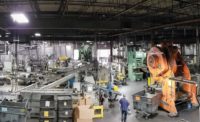RICHLAND, WA—Engineers at the Pacific Northwest National Laboratory (PNNL) here have developed a new manufacturing process that can convert recycled aluminum into parts for electric vehicles. They worked with Magna International Inc. on the foou-year R&D project that dramatically reduces the need to mine and refine raw aluminum ore.
The Shear Assisted Processing and Extrusion (ShAPE) process collects scrap bits and leftover aluminum trimmings from automotive manufacturing and transforms it directly into suitable material for new vehicle parts. It is now being scaled to make lightweight aluminum parts for EVs.
“We showed that aluminum parts formed with the ShAPE process meet automotive industry standards for strength and energy absorption,” says Scott Whalen, a materials scientist and lead researcher at PNNL. “The key is that ShAPE process breaks up metal impurities in the scrap without requiring an energy-intensive heat treatment step. This alone saves considerable time and introduces new efficiencies.”
Accoridng to Whalen, by reducing the cost of recycling aluminum, automakers and suppliers may be able to reduce the overall cost of aluminum components, better enabling them to replace steel.
While the automotive industry currently recycles most of its aluminum, it routinely adds newly mined primary aluminum to it before reusing it, to dilute impurities.
Metals manufacturers also rely on a century-old process of preheating billets to temperatures over 1,000 F for many hours. This step dissolves clusters of impurities such as silicon, magnesium or iron in the raw metal and distributes them uniformly in the billet through homogenization.
By contrast, the ShAPE process accomplishes the same homogenization step in less than 1 second, then transforms the solid aluminum into a finished product in a matter of minutes with no preheating step required.
“We have reached a critical milestone in the evolution of the ShAPE process,” explains Whalen. “We have shown its versatility by creating square, trapezoidal and multi-cell parts that all meet quality benchmarks for strength and ductility.”
Whalen and his colleagues worked with 6063 aluminum, an alloy that’s used for a variety of automotive components, such as engine cradles, bumper assemblies, frame rails and exterior trim. The PNNL engineers examined the extruded shapes using scanning electron microscopy and electron backscatter diffraction, which creates an image of the placement and microstructure of each metal particle within the finished product.
The results showed that the ShAPE products are uniformly strong and lack manufacturing defects that could cause parts failure. In particular, the products had no signs of the large clusters of metal—impurities that can cause material deterioration and that have hampered efforts to use secondary recycled aluminum to make new products.
The engineers are now examining high-strength aluminum alloys typically used in EV battery enclosure applications.
“This innovation is only the first step toward creating a circular economy for recycled aluminum in manufacturing,” claims Whalen. “We are now working on including post-consumer waste streams, which could create a whole new market for secondary aluminum scrap.”



